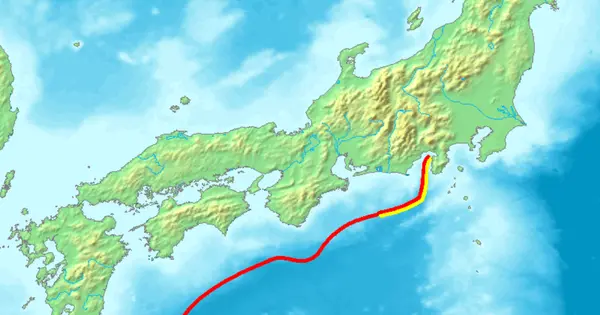The world is watching Japan in July, a month that a manga comic has predicted will bring an ominous event to the country. Ryo Tatsuki, dubbed the country’s Baba Vanga, seemingly alluded to the fact in a book from the 90s that earthquakes and tsunamis would devastate the region. She wrote that “a crack will open up under the seabed between Japan and the Philippines,” and the tremors will trigger waves “three times as tall” as the tsunami that wreaked havoc in the Tohoku region in 2011. Now, scientists have found that something is definitely going on under the ground in this specific region. Does this mean that the manga prediction will come true? The Nankai Trough, a subduction zone where the Philippine Sea Plate is being pushed beneath Japan, is experiencing slow-slip earthquakes, a study published in Science has found.
Slow-slip earthquakes are rare and have been observed occurring beneath the Pacific Ocean, off the coast of Japan. The Nankai Trough fault holds a prominent place when it comes to the earthquakes and tsunami risks Japan faces. Using advanced borehole observatories, scientists detected subtle seismic movements near the fault, revealing that shallow quakes have been shaking the region for years. They are just harder to detect and require special equipment. Such quakes also do not generate violent tremors, nor are they sudden or sharp, but gradually cut through the ground. The strain causes ruptures at the rate of only millimetres per day. Also Read: ‘A crack will open up…’: Eerie prophecy triggers panic among people visiting Japan, forcing mass cancellations
Faultlines in Japan and what is happening with them
The first observation of slow-slip earthquakes was in 2015, and then again in 2020. The new technology of borehole observatories noted that a stretch of about 20 miles along the fault was affected by the slow tremors. The movement started approximately 30 miles off Japan’s Kii Peninsula and crept towards the deep ocean trench. Scientists used the borehole tech to drill hundreds of feet into the seabed. They showed real-time data on how the fault behaves beneath the ocean. Also Read: One of Baba Vanga’s prophecies for 2025 has come true. She also predicted a war with Martians
Describing the slow-slip earthquakes, Josh Edgington, who analysed the data, said, “It’s like a ripple moving across the plate interface.” He said that while these earthquakes do not cause sudden devastation, they can help understand the behaviour of faults in subduction zones and their potential to generate tsunamis. However, things might be different at the Cascadia fault off the Pacific Northwest. It is largely “silent” compared to Nankai, and the concern is that if the fault remains locked, energy will continue to pile up and shake the Earth with the rare magnitude-9 megathrust earthquakes. Scientists now want to install similar borehole observatories in Cascadia and other fault lines, like the Pacific “Ring of Fire”, to look at if something scary is going on under there.
Related Stories


AloJapan.com